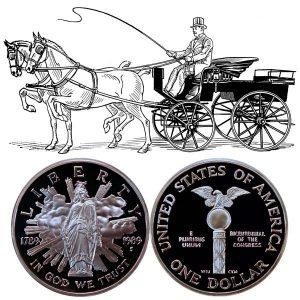Today, the Congress Commemorative Silver Dollar Coin remembers when General Washington’s phaeton transported at least one member of the Continental Congress to Lancaster, Pennsylvania then on to York.
The Continental Congress met for one day in Lancaster on September 27, 1777.
On September 14, 1777, Joseph Jones from Virginia, sent a letter to George Washington asking about his phaeton.
=====
Dear Sir:
Being in want of a light Phaeton I directed my servant to inquire about the City for one. He tells me he has found a single light carriage which belongs to you and has been lying here for some time. I have not seen it, but from his account of it, expect it will answer my purpose, and if you choose to sell, will purchase and give any price you may think it reasonably worth. If it is your inclination to keep it and get it out of the way of the Enemy I will take it to Lancaster if we are obliged to move there, which you will please to determine by a line. I am Your affable humble Servant, Joseph Jones
=====
On September 17th, General Washington responded:
=====
Yellow Springs,
Dear Sir: I have been favored with yours of the 14th. I do not wish to sell my phaeton, but shall be happy if you will take and use it till I shall have occasion for it. This I request you to do as you will thereby accommodate yourself and serve me at the same time.
=====
From the Continental Congress at York, Pennsylvania and York County in the Revolution by George R. Prowell, published in 1914:
=====
One Day at Lancaster.
In accordance with the resolu tion of Congress, when it ad journed at Philadelphia to meet at Lancaster, the members at Bethlehem proceeded to that borough on horseback, arriving there on the evening of Friday, September 26.
At this time the Pennsylvania Legislature had moved to Lancaster remaining in session there until June 20 of the following year.
Upon arriving at Lancaster, Congress assembled in the Court House then situated in Centre Square and began the transaction of business.
Several important letters were read.
One was received from General Gates, then in command of the Northern army near Saratoga. This letter dated September 15, on account of the exciting condition of affairs had been a long time on the way.
It was written four days before Gates had won his first victory at Saratoga.
A letter of great moment, dated September 23, was received from General Washington.
This letter was written at Pottstown which was then his headquarters and stated the condition of his army after the defeat of Brandywine, and the need of arms and supplies.
A resolution was then passed instructing the Board of War “to cooperate with General Washington in devising and carrying into execution effectual measures for supplying the army with firearms, shoes, blankets, stockings. provisions and other necessaries.”
The condition of affairs around Philadelphia at this period was not encouraging to the Americans.
Although Washington was receiving reinforcements there was still danger that he had not a sufficient army to defeat the enemy in a conflict which seemed inevitable.
Lancaster was only sixty-eight miles from Philadelphia and scouting parties of the enemy frequently approached the borders of the county in which Congress was assembled.
The Pennsylvania Legislature, then about to open its sessions at Lancaster, had begun to grow discouraged and disheartened by reason of the defeat of our army at Brandywine and the capture of Philadelphia by the British.
Some of its members were inimical to the cause of independence and others were opposed to Washington as the head of the army.
At the close of one day’s session at Lancaster, held on Saturday, September 27, the following resolution was adopted:
“Resolved, That the Treasury Board direct the treasurer, with all his papers, forms, etc., to repair to the town of York, in Pennsylvania.”
Immediately after the passage of this resolution, a motion was carried to adjourn to meet at York on the following Tuesday at 10 o’clock A. M.
Cross the Susquehanna.
These illustrious patriots whose acts and deeds have added lustre to the pages of American history, wended their way toward the Susquehanna in order that the broad river might flow between them and the enemy while they transacted the affairs of the infant government at York during the darkest period of the Revolution.
They crossed the river on flat boats at Wright’s Ferry and proceeded to York.
They rode on horseback, except John Hancock, who traveled in a chaise, and Joseph Jones, a member from Virginia, who came here in the private carriage of General Washington.
The following letter, written upon his arrival here, to the commander-in-chief, tells an interesting story:
York, Pa., September 30, 1777.
Dear Sir:
I have your phaeton here, though I was obliged to send for it after I left Philadelphia, being put to route the night I received your letter.
The bolt that fastens the pole part of the long reins was lost, some brass nails also gone and the lining much dirtied and in some places torn.
I will have these little matters repaired and the carriage and harness kept clean and in as good order as I can, which is the least I can do for the use, though I would rather buy it, if you are not determined against selling it and submit the price to yourself or your friend, Colonel Harrison, who may view it and pay the cash upon demand to your order.
The harness I observe is not matched, though the difference is not very striking. Whether these happened at Philadelphia since you left it there or before. you can judge.
…
=====
The Congress Commemorative Silver Dollar Coin shows with an artist’s image of a light phaeton pulled by two horses.
